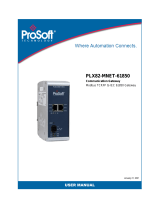
4. Time Setup
Set Up Time icon:
The Time Setup dialog appears:
Options are:
• Manual. Enter the correct
date and time.
• NTP. Select a time zone.
5. Confi gure Network Setup
Select the Network icon:
The Network Setup dialog appears:
If setting a Static IP, identify the IP
address you plan to use.
NOTE: Gateway and DNS1 are
required only if NTP is selected in
Time Setup. (see step 4)
6. Add Devices
Select the Devices icon:
Adding an Ethernet Device:
1. Name the Device.
2. Select the appropriate Ethernet protocol.
3. Select the appropriate TCP Port.
4. Enter the IP address of the Ethernet
device being connected to the Gateway.
5. If necessary, enter the slot number
where the processor is located.
6. Click Test Device Connection button.
Adding a Serial Device:
1. Name the Device.
2. Select the protocol the serial port
will be using.
3. Confi gure the serial port to which the
device will be connected. (See Step 7)
4. For most applications “Slot Number”
should be left at “0”.
5. Select the type of error checking
used by the PLC’s serial port protocol.
6. Some applications need the ACK
Timeout, NAK Retries, and ENQ
Retries values adjusted. If uncertain,
use the default values.
7. Click Test Device Connection button.
7. Confi gure Serial Ports
Confi gure the serial port on the Gateway to match the serial port
confi guration of the device to which you are connected.
8. Add Tags
The Gateway moves tag data between connected devices. For each
device connected to the Gateway, specify the tags from which data
will be read, and the tags to which that data will be written.
To add tags, select a device you added, and select the Add Tags icon:
Specify the following:
• Tag Name: Name the tag.
• Data Type:
Select data type of the named tag.
• Address: Enter the name of the tag
in the PLC, or the address of the
tag depending on the protocol.
• Byte Swap/Word Swap/Is Array:
Refer to user’s guide for more
detailed information. In most
applications, these boxes can
be left unchecked.
• NOTE: Tags can be imported
from a .csv fi le.
The Tag Properties dialog appears:
9. Create Tag Maps
A tag map executes a tag copy between PLCs.
Select the Tag Map icon:
To add a Tag Map, select the Add Tag Map Icon:
The Tag Map Editor dialog appears:
1. Specify the Source tag.
i. From “Available Tags”:
a. Select a Device.
b. Select the Tag that will be used as the data Source.
c. Confi rm the Source fi eld is highlighted, and select the Move Tag button:
2. Specify the Destination tag.
i. From “Available Tags”:
a. Select a Device.
b. Select the Tag that will be used as the data Destination.
c. Confi rm the Destination fi eld is highlighted, and select the Move Tag button.
3. Repeat steps 1 and 2 for each additional Source/Destination tag pair needed.
4. Name. Enter a name for the Tag Map.
5. Specify when a tag map executes:
• On Change: Executes a tag map on the state change of a specifi ed tag.
• Periodic: Executes the tag map on a user defi ned rate of frequency.
10. Activate Tag Map & View Live Tag Map Data
1. Activate the Tag Map to begin communication
between the Source and Destination tags, select:
2. Select the Live Tag Map Viewer to view the transfer of tag data:



